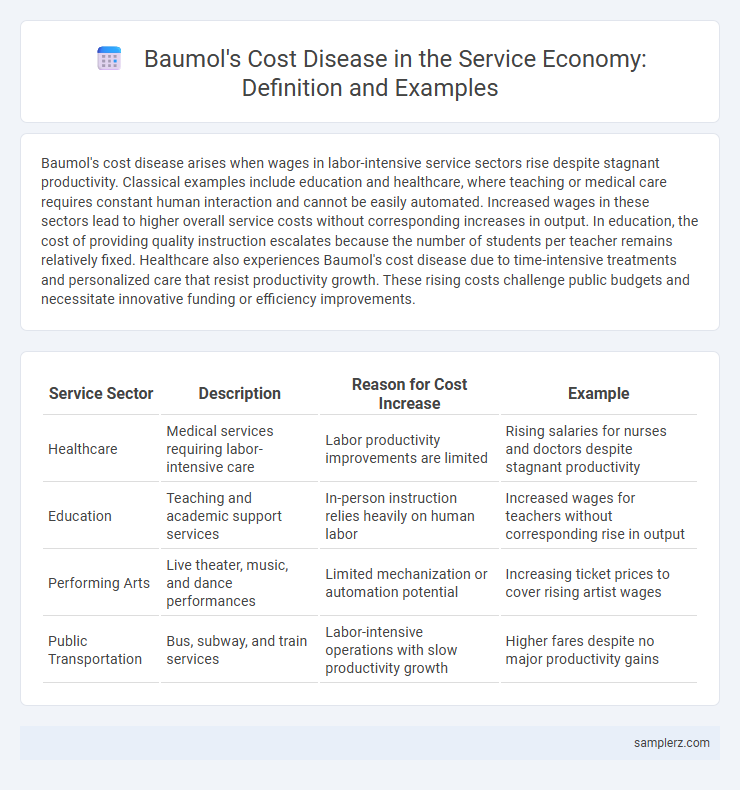Baumol's cost disease arises when wages in labor-intensive service sectors rise despite stagnant productivity. Classical examples include education and healthcare, where teaching or medical care requires constant human interaction and cannot be easily automated. Increased wages in these sectors lead to higher overall service costs without corresponding increases in output. In education, the cost of providing quality instruction escalates because the number of students per teacher remains relatively fixed. Healthcare also experiences Baumol's cost disease due to time-intensive treatments and personalized care that resist productivity growth. These rising costs challenge public budgets and necessitate innovative funding or efficiency improvements.
Table of Comparison
| Service Sector | Description | Reason for Cost Increase | Example |
|---|---|---|---|
| Healthcare | Medical services requiring labor-intensive care | Labor productivity improvements are limited | Rising salaries for nurses and doctors despite stagnant productivity |
| Education | Teaching and academic support services | In-person instruction relies heavily on human labor | Increased wages for teachers without corresponding rise in output |
| Performing Arts | Live theater, music, and dance performances | Limited mechanization or automation potential | Increasing ticket prices to cover rising artist wages |
| Public Transportation | Bus, subway, and train services | Labor-intensive operations with slow productivity growth | Higher fares despite no major productivity gains |
Understanding Baumol’s Cost Disease in the Service Sector
Baumol's cost disease explains rising costs in labor-intensive service sectors like education and healthcare, where productivity gains lag behind manufacturing. For example, a live theater performance requires the same number of musicians as decades ago, limiting productivity improvements and driving up wages without corresponding output growth. This phenomenon causes persistent inflation in service industries due to wage increases matched across sectors despite stagnant productivity.
The Rising Costs of Healthcare Services
Healthcare services exemplify Baumol's cost disease as labor-intensive treatments require significant time and skilled professionals, limiting productivity gains despite technological advancements. The increasing wages for healthcare workers drive costs upward, reflecting stagnant productivity but rising demand for quality care. Hospitals and clinics face escalating expenses without proportional output growth, intensifying the pressure on healthcare budgets worldwide.
Education Expenses: A Case of Baumol’s Cost Disease
Education expenses exemplify Baumol's cost disease as rising salaries in teaching outpace productivity gains due to the labor-intensive nature of instruction. Unlike manufacturing, where automation boosts output, education requires sustained human interaction, causing costs to escalate without corresponding efficiency improvements. This persistent increase in costs challenges budget allocations for schools and universities, highlighting the economic impact of Baumol's cost disease in the service sector.
Performing Arts and Escalating Labor Costs
Baumol's cost disease is evident in the performing arts, where labor-intensive productions like theater and orchestras experience rising costs despite stagnant productivity. Escalating labor costs stem from the need to maintain skilled performers and technical staff, whose wages increase in line with other sectors offering higher productivity gains. This phenomenon results in persistent budget pressures for arts organizations, often requiring increased ticket prices or public funding to sustain operations.
Legal Services: Increasing Prices Despite Stagnant Productivity
Baumol's cost disease is evident in legal services, where rising costs persist despite stagnant productivity levels. Legal work relies heavily on labor-intensive tasks that resist automation, causing wages to increase in line with other sectors without corresponding gains in output. Consequently, legal fees continue to escalate, reflecting wage inflation rather than improvements in efficiency.
Public Administration and Baumol’s Cost Dynamics
Baumol's cost disease manifests in Public Administration through rising labor costs despite stagnant productivity growth, as essential services require consistent human involvement and cannot be easily automated. Salary increases in government offices reflect Baumol's cost dynamics, where wages rise in line with more productive sectors despite limited efficiency gains. This results in escalating operational expenses and challenges in budget allocation for public institutions.
Childcare Industry: Wages versus Productivity Growth
Baumol's cost disease is evident in the childcare industry where wages rise despite stagnant productivity growth due to the labor-intensive nature of services. Childcare providers must increase salaries to attract qualified staff, yet the output per worker remains relatively unchanged because child supervision requires constant human interaction. This wage-productivity gap drives up service costs, highlighting the economic challenge of maintaining affordable childcare while ensuring quality care.
Hospitality Sector Facing Baumol’s Cost Challenges
The hospitality sector experiences Baumol's cost disease as wages rise in labor-intensive services like hotels and restaurants without matching productivity gains. Rising labor costs lead to increased prices for accommodation and dining, pressuring profit margins amid stagnant technological advancements. This dynamic challenges the sector's competitiveness and affordability while maintaining service quality.
Municipal Services and Cost Disease Implications
Municipal services such as public education, firefighting, and policing exemplify Baumol's cost disease by exhibiting rising labor costs despite limited productivity growth. These services require labor-intensive tasks that cannot be easily automated, causing wages to increase in line with other sectors while output remains relatively constant. The cost disease implications lead to escalating budget pressures for local governments, necessitating higher taxes or reallocation of resources to maintain service quality.
Long-Term Care Facilities: Cost Drivers Explained
Long-term care facilities experience Baumol's cost disease as labor-intensive services require wage increases despite limited productivity growth, driving up operational costs. Staffing expenses, including nursing and personal care aides, constitute the largest cost component, reflecting the sector's dependency on human resources. Rising wages without corresponding efficiency gains lead to persistent cost inflation in long-term care services.

example of Baumol’s cost disease in service Infographic
 samplerz.com
samplerz.com